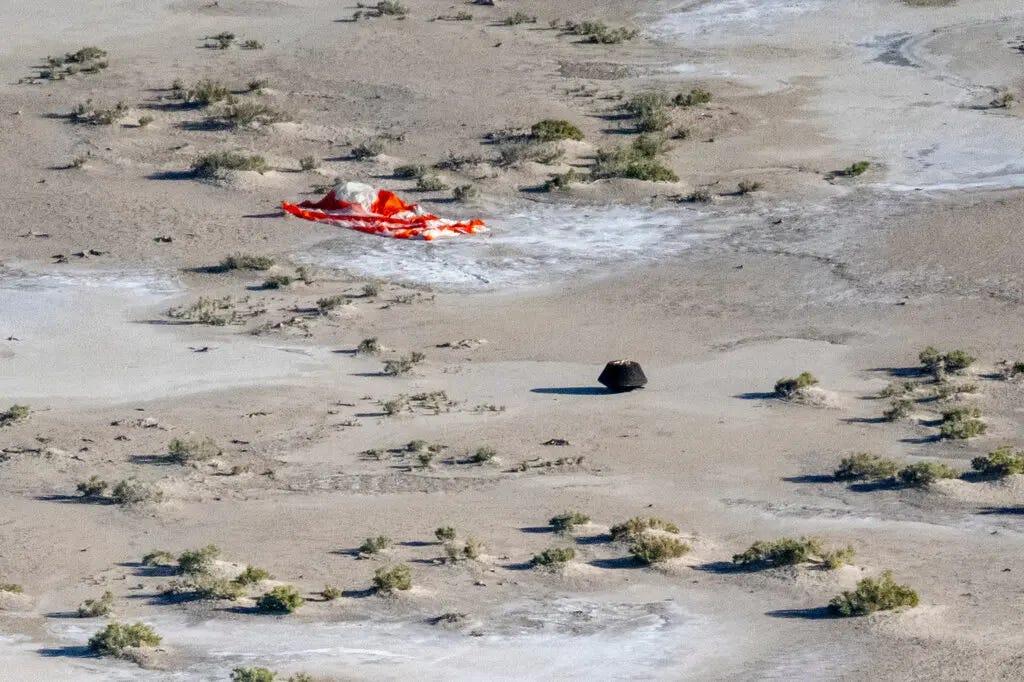September 24, 2023

Hello again Science Fans!
Just before 7:52 AM (PDT) this morning, NASA’s OSIRIS-REx mission returned the sample recovery capsule (SRC) containing material from the asteroid Bennu to a desert area in Utah. This is a remarkable achievement. First, they had to get to Bennu, which involved some complicated orbital mechanics. Then they had to orbit the asteroid, the smallest space object ever orbited by a satellite. Next, they had to successfully obtain a sample of the asteroid’s surface, deposit it in a container, and close the lid. That last part proved tricky, but eventually they were successful. After some more exploring around the asteroid, the spacecraft then had to return to Earth and drop the SRC into the atmosphere, before continuing on to another near-earth asteroid, Apophis. The SRC then was to enter earth’s atmosphere over San Francisco, decelerate, and land in the designated area in the Utah desert at the leisurely speed of roughly 11 miles per hour.
Now the real fun begins as the material returned from Bennu is analyzed. Scientists hope to find ancient, uncontaminated evidence of the early days of our Solar system.
Congratulations to all involved. Here’s a link to a NY Times article on the history of the mission.
There’s much more news from space this week.
On Mars, the Curiosity rover reached the Gedez Vallis Ridge after three failed attempts. This ridge holds proof of Mars’ watery history, which included significant landslides. Curiosity has been on Mars for 9 years now!
And Ingenuity, the intrepid Mars helicopter that landed on Mars with the Perseverance rover, broke an altitude record on its 59th flight, reaching 66 feet above the Martian surface.
The research being conducted using James Webb Space Telescope images continues to surprise scientists, raising questions regarding long-held views of the origin or the universe. Using JWST to look back to just 600 million years after the Big Bang, researchers have determined that early galaxies didn’t follow the same “rules” as later galaxies. The heavy metals they expected weren’t present.
JWST also detected carbon on Jupiter’s moon Europa, moving scientists closer to determining if Europa’s oceans could support life.
Here on Earth, archaeology allows us to examine how ancient civilizations lived their lives. The recent discovery of a 500,000 year old wooden structure has archaeologists rethinking their assumptions about how technologically advanced pre-homo-sapiens may have been.
In Britain, work on a new, high speed railway linking London and Birmingham, dubbed HS2, has archaeologists excited. Numerous discoveries have been made during the pre-construction archaeology survey, including entire settlements.
At 11:50 PM PDT last Friday, September 22, the sun was directly over the equator, marking the autumnal equinox, or the start of fall in the Northern hemisphere. You thought the equinox was always on the 21st? Nope. And despite the name (equinox means equal night), day and night are not the same length on the equinox. Here’s everything you ever wanted to know about the equinox, and more!
I flew back to the Bay Area last Tuesday from Europe. I was a little surprised to see all the smoke in the air as we approached SFO. Apparently it is coming from forest fires near the Oregon border. The first study to examine the effects of the past 20 years of landscape fires across the globe has produced some sobering results. Over 2 billion people are exposed to at least one day a year of health-impacting hazards.
While the Bay Area, and the US as a whole, have made a lot of progress fighting air pollution, with PM2.5 pollution declining 38%, much of that progress has been lost to wild fire smoke pollution, according to a new Stanford University study.
We sometimes reference articles from physicist Sabine Hossenfelder. Here’s an article about her and her adventures in social media.
Lastly, my picks for this week:
- Second Chances for Sea Otters – Livestream – 09/25/2023 12:00 PM
- The Secret Life of Harbor Porpoises, New Insights into Mating Behavior and Implications for Conservation – Livestream – 09/26/2023 07:00 PM
- Imitation and Innovation in AI: What Four-year-olds Can Do and AI Can’t (Yet) – 09/27/2023 12:00 PM
- College of San Mateo’s Family Science & Astronomy Festival + Makerspace – 09/30/2023 01:00 PM
Have a great week in Science!
Bob
Upcoming Events:
Click to see the next two weeks of events in your browser.
